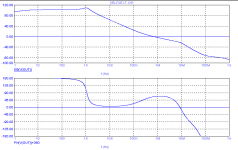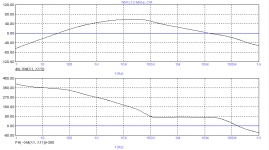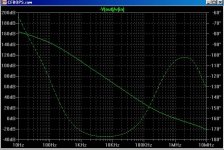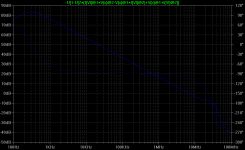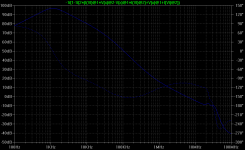Re: Re: TMC
I said 'global', that's what count most. What else are we talking about?
Read again post #71: "NDFL neither TMC does NOT overshoot and the global NFB loop doesn't dip."
Notice that I even used bold chars for the word 'global'.
BTW, that graph on your post #47, isn't that the global loop response?
Below you see the global amplitude and phase loop response of an amplifier with TPC. Almost identical.
Only this topology has that ******* phase dip at around 10kHz.
To repeat myself, it is this amp/phase response that explains why, opposed to TMC and NDFL, TPC results in overshoot.
That's right, it's the phase response of the global NFB loop of an amplifier to which NDFL is applied. Any objections that I'm using amplifiers to ***** the merits of different amplifier topologies? But if you know better of techniques to characterize these merits, please tell us.
Cheers,
Edmond.
G.Kleinschmidt said:
When did I say "global"?
I said 'global', that's what count most. What else are we talking about?
Read again post #71: "NDFL neither TMC does NOT overshoot and the global NFB loop doesn't dip."
Notice that I even used bold chars for the word 'global'.
BTW, that graph on your post #47, isn't that the global loop response?
Below you see the global amplitude and phase loop response of an amplifier with TPC. Almost identical.
Only this topology has that ******* phase dip at around 10kHz.
To repeat myself, it is this amp/phase response that explains why, opposed to TMC and NDFL, TPC results in overshoot.
This is not a phase response of NDFL.
That's right, it's the phase response of the global NFB loop of an amplifier to which NDFL is applied. Any objections that I'm using amplifiers to ***** the merits of different amplifier topologies? But if you know better of techniques to characterize these merits, please tell us.
Cheers,
Edmond.
Attachments
Re: Re: Re: TMC
Your religious mission against TPC is inane and it is starting the get rather boring - and you're still banging on about that damn overshoot
I'm quite aware that NDLF and TMC do not cause overshoot as does TPC and your blanket claim that NDFL does not cause a mid-band phase dip is just nonsense.
I guess you can just disregard all previous analysis of Cherry’s designs, including the phase response I attached again to post 72 in this thread! TMC can also have similar mid-band phase characteristics within the Miller loop.
Dismissing a compensation technique because it causes a mid-band phase dip (overshoot or no overshoot) is just as nonsensical and pseudo-technical as calling an amplifier with an open loop bandwidth of 100Hz slow, IMHO.
Edmond Stuart said:
I said 'global', that's what count most. What else are we talking about?
Read again post #71: "NDFL neither TMC does NOT overshoot and the global NFB loop doesn't dip."
Notice that I even used bold chars for the word 'global'.
BTW, that graph on your post #47, isn't that the global loop response?
Below you see the global amplitude and phase loop response of an amplifier with TPC. Almost identical.
Only this topology has that ******* phase dip at around 10kHz.
To repeat myself, it is this amp/phase response that explains why, opposed to TMC and NDFL, TPC results in overshoot.
That's right, it's the phase response of the global NFB loop of an amplifier to which NDFL is applied. Any objections that I'm using amplifiers to ***** the merits of different amplifier topologies? But if you know better of techniques to characterize these merits, please tell us.
Cheers,
Edmond.
Your religious mission against TPC is inane and it is starting the get rather boring - and you're still banging on about that damn overshoot
I'm quite aware that NDLF and TMC do not cause overshoot as does TPC and your blanket claim that NDFL does not cause a mid-band phase dip is just nonsense.
I guess you can just disregard all previous analysis of Cherry’s designs, including the phase response I attached again to post 72 in this thread! TMC can also have similar mid-band phase characteristics within the Miller loop.
Dismissing a compensation technique because it causes a mid-band phase dip (overshoot or no overshoot) is just as nonsensical and pseudo-technical as calling an amplifier with an open loop bandwidth of 100Hz slow, IMHO.
religious war?
>I'm quite aware that NDLF and TMC do not cause overshoot as does TPC and your blanket claim that NDFL does not cause a mid-band phase dip is just nonsense.
Then tell me, why NDLF and TMC do not cause overshoot? Because there ain't no mid-band phase dip comparable to TPC, talking about 'nonsense'.
>TMC can also have similar mid-band phase characteristics within the Miller loop.
 That's not my experience. Perhaps you should switch to another simulator.
That's not my experience. Perhaps you should switch to another simulator. 
Below the MIller loop response of MY NDFL amp. Dip?!
>I'm quite aware that NDLF and TMC do not cause overshoot as does TPC and your blanket claim that NDFL does not cause a mid-band phase dip is just nonsense.
Then tell me, why NDLF and TMC do not cause overshoot? Because there ain't no mid-band phase dip comparable to TPC, talking about 'nonsense'.
>TMC can also have similar mid-band phase characteristics within the Miller loop.
 That's not my experience. Perhaps you should switch to another simulator.
That's not my experience. Perhaps you should switch to another simulator. 
Below the MIller loop response of MY NDFL amp. Dip?!

Attachments
A mid-band phase dip does not necessarily mean overshoot. The reason why Cherry's NDFL amplifier with ~180 degrees mid-band open loop phase doesn't cause any overshoot was discussed in the negative feedback thread (see the discussion between traderbam and andy-c back when the merits of TPC Vs NDFL was being discussed.)
I suspect you know this well, but are just being disingenuous. I’ll attach once again the loop gain and phase response of Cherry’s amplifier. This NDFL amp does not generate any overshoot.
Hint: look! There is no gain peaking at the point at which the open loop gain starts to roll-off.
I suspect you know this well, but are just being disingenuous. I’ll attach once again the loop gain and phase response of Cherry’s amplifier. This NDFL amp does not generate any overshoot.
Hint: look! There is no gain peaking at the point at which the open loop gain starts to roll-off.
Attachments
Re: Re: Re: Re: TMC
I have seen this also, with the circuit configuration of this post (Blameless with PSRR mod, VAS with inverted EF + Hawksford cascode). In order to stabilize the Miller loop, I needed lots of emitter degen in the CE stage, along with a very low Miller cap. The Miller loop gain is quite large, even down to pretty low frequencies. I'll try to post a before and after TMC plot of the Miller loop gain later today.
G.Kleinschmidt said:TMC can also have similar mid-band phase characteristics within the Miller loop.
I have seen this also, with the circuit configuration of this post (Blameless with PSRR mod, VAS with inverted EF + Hawksford cascode). In order to stabilize the Miller loop, I needed lots of emitter degen in the CE stage, along with a very low Miller cap. The Miller loop gain is quite large, even down to pretty low frequencies. I'll try to post a before and after TMC plot of the Miller loop gain later today.
G.Kleinschmidt said:Nope. I've never built anything. Only ever made electronic circuits in spice. Never layed out a circuit board either. I'm still learning how to do analogue stuff. I hope one day to learn about digital logic too.
Glen - Joker!!
G.Kleinschmidt said:
Hi
The phase dip really isn't an issue and will always be there with TPC. NDFL (and TMC, if investigated proerly) actually do the same thing. There isn't any ringing at all on low frequency squarewaves.
There are two things that really matter, as far as stability goes. These are the phase margin at 0dB loop gain and the "gain margin". The latter is the loop gain when the phase shift hits 180 degrees (after the unity loop gain frequency).
In this case the gain marging is 20dB, which is an adequate target.
Cheers,
Glen
Hi Glenn,
One thing that can sometimes happen is that when power is removed the gain can drop, reducing the gain crossover frequency into the region of frequencies where the phase dip is. If, at the same time, some added phase lag has occurred due to the starved circuitry, a brief burst of oscillation may occur as the circuit dies on power off. This may not be that great a concern, but it may be worth noting.
Cheers,
Bob
Re: Re: Re: Re: Re: TMC
Okay, here is a plot of the Miller loop gain of the referenced circuit with no TMC. It's about as expected.
andy_c said:I have seen this also, with the circuit configuration of this post (Blameless with PSRR mod, VAS with inverted EF + Hawksford cascode). In order to stabilize the Miller loop, I needed lots of emitter degen in the CE stage, along with a very low Miller cap. The Miller loop gain is quite large, even down to pretty low frequencies. I'll try to post a before and after TMC plot of the Miller loop gain later today.
Okay, here is a plot of the Miller loop gain of the referenced circuit with no TMC. It's about as expected.
Attachments
And here is a plot of the Miller loop gain of the same circuit with TMC enabled. You can see there's an effect on the Miller loop gain similar to what happens to the global loop gain with TPC. I don't claim this effect to be universal by any means, but it does seem to happen with some, albeit unusual, configurations.
Attachments
Assessment of loop x-fer functions
Glen, don't you see you are getting quite annoying. You are just not smart enough to justify using words like 'nonsense' or 'disingenuous' and making silly jokes.
Apparently you didn't ask yourself why, if NDFL and TMC would indeed also show a phase dip at ~10kHz, yet they don't overshoot. Does it never occur to you that this is rather weird? Also, does it never occur to you that for this reason your sims are flawed, the more so as my sims don't reveal those phase dips?
BTW, I know exactly what you did wrong, but, giving your attitude, I'm not much inclined to help you on this matter. Just figure it out by yourself.
G.Kleinschmidt said:I'm quite aware that NDLF and TMC do not cause overshoot as does TPC and your blanket claim that NDFL does not cause a mid-band phase dip is just nonsense.
..............
I suspect you know this well, but are just being disingenuous. I’ll attach once again the loop gain and phase response of Cherry’s amplifier. This NDFL amp does not generate any overshoot.
.................
Thanks Andy. Looks like you need a new simulator that works properly too
Glen, don't you see you are getting quite annoying. You are just not smart enough to justify using words like 'nonsense' or 'disingenuous' and making silly jokes.
Apparently you didn't ask yourself why, if NDFL and TMC would indeed also show a phase dip at ~10kHz, yet they don't overshoot. Does it never occur to you that this is rather weird? Also, does it never occur to you that for this reason your sims are flawed, the more so as my sims don't reveal those phase dips?
BTW, I know exactly what you did wrong, but, giving your attitude, I'm not much inclined to help you on this matter. Just figure it out by yourself.

Isn't this just a matter of where the loop gain probe goes? I'm thinking in terms of Figure 3 of this article by Vanderkooy and Hawksford (PDF file), which compares NDFL and noise shaping.
Re: Assessment of loop x-fer functions
 There is nothing wrong with my sims showing the > 90% phase dip of that NDFL amp and it is obvious that a comment or two of mine has hit a nerve.
There is nothing wrong with my sims showing the > 90% phase dip of that NDFL amp and it is obvious that a comment or two of mine has hit a nerve.
And don't worry, I really don't care any more for your lecturing, or charitably pandering to your superiority complex. You’ve been added to my ignore list.
Edmond Stuart said:
Glen, don't you see you are getting quite annoying. You are just not smart enough to justify using words like 'nonsense' or 'disingenuous' and making silly jokes.
Apparently you didn't ask yourself why, if NDFL and TMC would indeed also show a phase dip at ~10kHz, yet they don't overshoot. Does it never occur to you that this is rather weird? Also, does it never occur to you that for this reason your sims are flawed, the more so as my sims don't reveal those phase dips?
BTW, I know exactly what you did wrong, but, giving your attitude, I'm not much inclined to help you on this matter. Just figure it out by yourself.
 There is nothing wrong with my sims showing the > 90% phase dip of that NDFL amp and it is obvious that a comment or two of mine has hit a nerve.
There is nothing wrong with my sims showing the > 90% phase dip of that NDFL amp and it is obvious that a comment or two of mine has hit a nerve.And don't worry, I really don't care any more for your lecturing, or charitably pandering to your superiority complex. You’ve been added to my ignore list.
Re: Re: Assessment of loop x-fer functions
If there is nothing wrong with his sims then his NDFL amp itself is wrong.
And the TMC amp? Dropped from his 'dip list'? Great! He is learning fast.
Clearly, GK is running out of arguments. Anyhow, thanks, GK! Saves me a lot of time and boring discussions too.
BTW, do you folks remember our (boring) discussion about simulating the global NFB loop (of a conventional amp) a few years ago? Also in that case, GK's approach was fundamentally flawed.
G.Kleinschmidt said:There is nothing wrong with my sims showing the > 90% phase dip of that NDFL amp and it is obvious that a comment or two of mine has hit a nerve.
If there is nothing wrong with his sims then his NDFL amp itself is wrong.
And the TMC amp? Dropped from his 'dip list'? Great! He is learning fast.
And don't worry, I really don't care any more for your lecturing, or charitably pandering to your superiority complex. You’ve been added to my ignore list.
Clearly, GK is running out of arguments. Anyhow, thanks, GK! Saves me a lot of time and boring discussions too.
BTW, do you folks remember our (boring) discussion about simulating the global NFB loop (of a conventional amp) a few years ago? Also in that case, GK's approach was fundamentally flawed.
- Status
- This old topic is closed. If you want to reopen this topic, contact a moderator using the "Report Post" button.
- Home
- Amplifiers
- Solid State
- A superior VAS clamp and VAS current limit for the Blameless.

